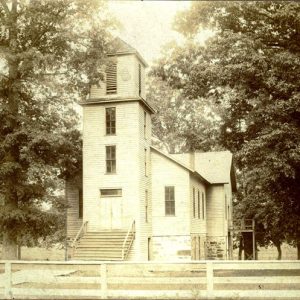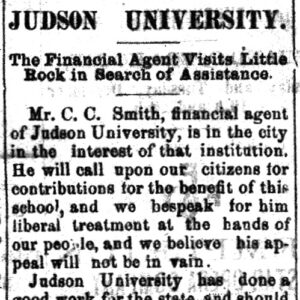calsfoundation@cals.org
Judson University
Judson University was a short-lived institution of higher education in Prospect Bluff—present-day Judsonia (White County). The institution stimulated the migration of Northern families to the area, thereby significantly increasing the population and refining the social atmosphere of this typical, mid-nineteenth-century river town.
Judson University began as the dream of Professor Martin R. Forey of Chicago, Illinois. Forey was a professor at Chicago University and had established Chowan Female Institute in Murfreesboro, North Carolina. He believed it was his calling to establish Christian schools and, in 1869, traveled to Arkansas to found a Baptist college in the South. His first stop in Prairie County was met with hostility, but he received a lukewarm welcome in White County.
Forey returned to Chicago in 1870 and began to promote his dream of a Baptist college to other Baptists in Illinois, Iowa, Michigan, and Ohio. He named his new university after the first foreign American missionary, Adoniram Judson. Forey returned in early 1871 with a colony about forty strong, which made its home in Prospect Bluff, a town on the Little Red River with a population of about 250. Forey purchased five acres on the outskirts of town (the land lies just south of present Highway 367 and Boardman Avenue). Shortly thereafter, he applied for a charter from the state, which was granted on March 27, 1871, by Acting Governor Ozro Amander Hadley. In November 1871, Forey purchased an additional 250 acres to complete the campus. The extra land was to be sold as home sites to provide money for the university and entice Northerners to come to Arkansas.
Minutes from the meeting of the board of trustees show that, on the afternoon of November 2, 1871, the board and Forey designated the site of the first building. Forey opened the school before the end of the year in its new 30′ x 45′ building. The members of the founding board were Martin Forey (president), Dr. Amos Walker (secretary), Byron Brown, Elisha Kelley, David Hanchett, Jeremiah Mason, Curtis Halstead, John Beaver, and Isaac Young. Added later were Dr. Robert C. Browning and Warren N. Briggs. In 1872, Walker started the First Baptist Church, and, later that year, the university gave the city land for a city park.
Judson University had an ambitious curriculum and an experienced staff but very little money. At the height of its operations, more than 100 scholars were at the university being instructed in biology, geology, English, math, foreign languages, theology, telegraphy, painting, and elocution by a faculty of five. Forey was away from the university much of the time, traveling to Little Rock (Pulaski County), St. Louis, and Chicago to solicit funds and students. On May 5, 1874, the board of trustees established Evergreen Cemetery to provide another source of revenue. In 1875, the school was flourishing, with funds from the sale of school-owned land and a growing enrollment. Its new president, Dr. Benjamin Thomas, made plans to expand the building. He ordered the present building moved (to the site of present-day Judsonia Junior High School) and expanded to two stories with a steeple. During this time, the population of the town doubled due in part to the success of the university in attracting families. Prospect Bluff had been incorporated May 3, 1872, and the nearby settlement of Judsonia, just to the north, was incorporated ten days later. With the encouragement of Northerners, led by Forey, the two towns were united and blended into one town, using the name of Judsonia, on April 7, 1874.
Money was soon again in short supply, as no statewide funding from the Southern Baptist churches could be obtained, and the 1883 term proved to be the last for Judson University, the land having been foreclosed. The school opened briefly again in 1888 but did not last a single term. On November 28, 1901, the board of trustees voted to transfer the last remaining asset of the university, Evergreen Cemetery, to the cemetery board. What remains of the school, the steeple bell, is in use at Judsonia’s First Baptist Church.
For additional information:
Minute book of the Board of Trustees of Judson University, November 2, 1871–November 28, 1901. Archives of First Baptist Church, Judsonia, Arkansas.
Orr, W. E. That’s Judsonia. Judsonia, AR: White County Printing Co., 1957.
Short, Elizabeth. So Great a Cloud of Witnesses. Winona, MN: Apollo Books, 1985.
Dick E. Browning
Maumelle, Arkansas
 Post-Reconstruction through the Gilded Age, 1875 through 1900
Post-Reconstruction through the Gilded Age, 1875 through 1900 Judson University
Judson University  Judson University Assistance Story
Judson University Assistance Story 




Comments
No comments on this entry yet.